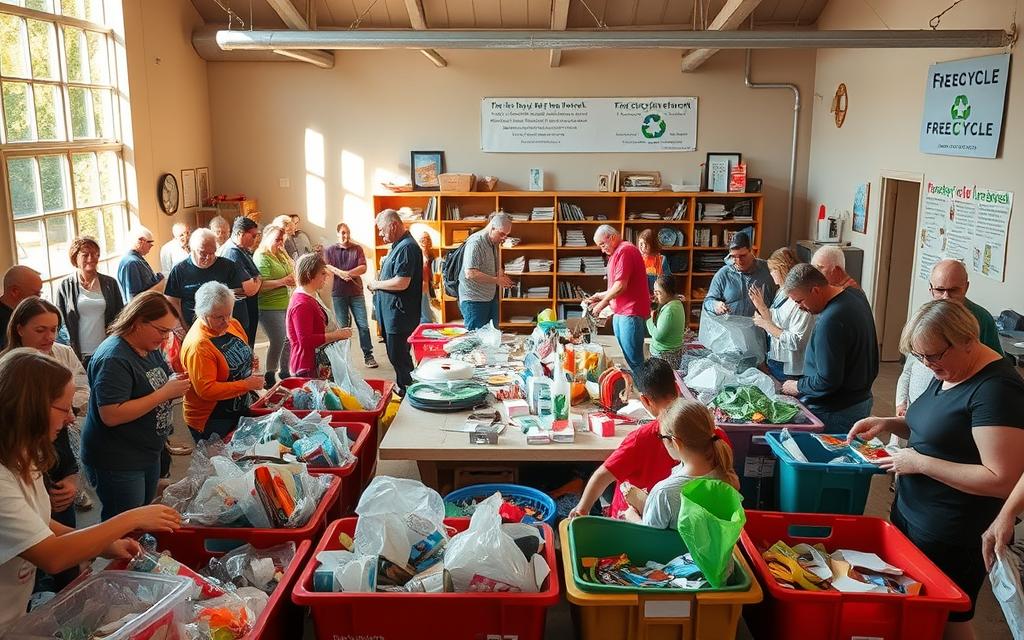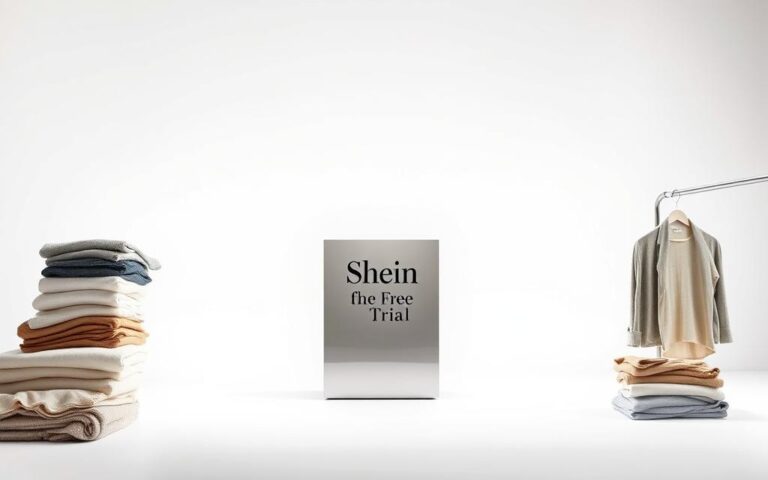Advertisement
Did you know millions of tons of waste go to landfills yearly? Yet, many people need goods and resources. The Freecycle Network connects those who want to give and receive for free. It promotes sustainable living.
This community sharing platform helps clean up homes and builds community. By joining, you can give away items you don’t need and get something useful for free. It reduces waste and helps those in need.
Exploring this platform, you’ll see how simple it is to start. You can make a big difference in your local community.
What Is the Freecycle Network?
Freecycle is a unique online platform that changes how we view waste and use. It’s a nonprofit that links people who have items they don’t need with those who do, for free.
Understanding the Concept of Freecycling
Freecycling is about giving away items for free to those who need them. It helps reduce waste and supports sustainability. It’s based on the idea that someone’s unwanted item can be another’s treasure. By freecycling, people can clean their homes and help the environment.

The Origins of the Freecycle Movement
The Freecycle Network began in 2003 in Tucson, Arizona, by Deron Beal. It started as a local effort to cut down on waste. Now, it’s a global movement with thousands of groups worldwide. It’s all about keeping useful items out of landfills by giving them away.
How Freecycle Works in Everyday Life
Freecycle works through local online groups. Members post items they want to give away or need. It’s easy: members look for items, offer what they have, and arrange pickups or drop-offs. This helps reduce waste and builds community.
Some benefits of Freecycle include:
- Reducing waste and promoting sustainability
- Finding unique or hard-to-find items for free
- Building connections within the local community
- Decluttering homes without selling items
Understanding Freecycle helps us see its value. It shows how it supports a greener lifestyle.
Benefits of Joining Freecycle
Freecycle offers many benefits, like reducing waste and saving money. It lets users give away items for free. This helps declutter homes and supports a greener environment.
Environmental Advantages
Freecycle has a big positive effect on the environment. It helps reduce waste by reusing and recycling items. This saves landfill space and cuts down on environmental harm from making, moving, and throwing away goods.
“Freecycle embodies the spirit of sharing and community, helping to reduce, reuse, and recycle, making our world a cleaner place.”
A study shows the average American throws away about 4.4 pounds of trash daily. Freecycle lets people help lower this number.
Financial Savings for Users
Joining Freecycle can also save money. Users avoid disposal costs by giving away items they no longer need. They also get useful items for free, which means they don’t have to buy new things.
- Save money on disposal costs
- Acquire items for free
- Reduce the need for new purchases
A survey found many Freecycle users save money by getting items for free and cutting down on waste disposal costs.
| Benefits | Description | Impact |
|---|---|---|
| Reduce Waste | Giving away unwanted items | Less landfill waste |
| Financial Savings | Acquiring free items | Lower household expenses |
| Community Building | Connecting with locals | Stronger community ties |
Strengthening Local Communities
Freecycle also strengthens local communities. It helps people exchange goods and services. This builds connections among neighbors and fosters a sense of community.
Many users say Freecycle has helped them meet new people and build strong community bonds. This is very valuable today, when we often lack face-to-face interactions.
Freecycle promotes eco-friendly living and local exchange. It helps create a more sustainable and connected world.
How to Get Started with Freecycle
Starting with Freecycle is easy. Just find your local group and make a profile. The Freecycle Network is a global community. It helps people share and reuse items, reducing waste and building local connections.
Finding Your Local Freecycle Group
To join Freecycle, first find your local group. Visit the Freecycle website and use their group finder. Enter your location to find your group. This way, you can easily give and receive items with people nearby.
Tips for Finding Your Group:
- Use the Freecycle group finder tool on their official website.
- Enter your city or zip code to find your local group.
- Check your email for confirmation and instructions on how to participate.
Creating an Effective Profile
After finding your group, create a profile. Your profile should clearly state who you are and what you’re looking for or willing to give. This helps others understand how they can help you or contribute to the group.
Remember, your profile is your introduction to the community. Make it count!
Tips for First-Time Users
As a first-timer, you might feel unsure about using Freecycle. Here are some tips to help you:
- Familiarize yourself with the group’s rules and guidelines.
- Start by giving: Offer items you no longer need to get a feel for how the community works.
- Be clear and concise in your posts: Whether you’re giving or requesting an item, make sure your description is accurate.
- Be responsive: If someone is interested in an item you’ve offered, respond promptly to arrange a pickup or exchange.
By following these steps and tips, you’ll become an active and valued member of your local Freecycle community.
Giving Back: How to Donate Through Freecycle
Donating items through Freecycle helps make our living more sustainable and builds community. It not only clears out our homes but also keeps items from ending up in landfills.
What Items Can You Offer?
Freecycle lets you give away many things, like clothes and home goods. Make sure what you give away is still useful. Here are some examples:
- Gently used clothing and accessories
- Household items such as kitchenware, linens, and decor
- Toys and children’s items that are still in good condition
- Books, CDs, and DVDs
- Furniture that is still functional
Before you post, check if your item is okay for Freecycle. Some things, like hazardous waste, are not allowed.
Best Practices for Posting Items
When you post items, be clear and detailed. Here’s how:
- Clear Description: Tell what the item is, its condition, and any problems.
- Good Photos: Show the item from different sides with good lighting.
- Specific Location: Say where you are so people can find you.
These tips help make the process smooth and build trust in the community.
Ensuring a Positive Giving Experience
To have a good experience, be quick to respond and polite. Here’s how:
- Answer questions fast and set up pickups quickly.
- Be honest about the item’s condition and any other important details.
- Be kind and respectful to other Freecycle members.
Being positive encourages more people to join Freecycle, making our community stronger.
| Item Category | Examples | Condition |
|---|---|---|
| Clothing | Shirts, pants, dresses | Gently used, no stains or tears |
| Household | Kitchenware, linens, decor | In good condition, functional |
| Toys and Children’s Items | Toys, strollers, children’s books | Gently used, clean, and safe |
Tips for Finding Great Freecycle Items
Freecycle is more than just a platform; it’s a community that thrives on giving and receiving. Here’s how to make the most of it. To get the best out of Freecycle, users need to be strategic in their approach.
Strategies for Effective Browsing
Effective browsing on Freecycle involves being specific about what you’re looking for. Also, be quick to respond to new listings. Here are some strategies to enhance your browsing experience:
- Use specific keywords related to the item you need.
- Regularly check the “offer” section for new listings.
- Be prepared to act fast when you see an item you’re interested in.
Setting Up Alerts for Desired Items
Setting up alerts can streamline your search process on Freecycle. By doing so, you can receive notifications about new listings that match your criteria. This saves you time and increases your chances of finding what you need.
To set up alerts:
- Log into your Freecycle account.
- Navigate to the “Settings” or “Preferences” section.
- Enter the keywords for the items you’re looking for.
- Choose your preferred notification frequency.
Building Relationships Within the Community
Building relationships within the Freecycle community can significantly enhance your experience. By being an active and respectful member, you can increase your visibility. This builds trust with other users.
Here are some tips for building strong community relationships:
- Respond promptly to messages and offers.
- Be clear and respectful in your communications.
- Consider giving as well as receiving to maintain a balanced exchange.
To illustrate the effectiveness of these strategies, let’s look at some data on successful Freecycle transactions:
| Strategy | Success Rate | User Satisfaction |
|---|---|---|
| Effective Browsing | 75% | High |
| Setting Up Alerts | 85% | Very High |
| Building Relationships | 90% | Excellent |
By implementing these strategies, you can enhance your Freecycle experience. This contributes to a more sustainable and connected community. Whether you’re looking for something specific or just browsing, Freecycle offers a unique opportunity to engage in local exchange and promote eco-friendly living.
Success Stories from Freecycle Users
Freecycle has changed how we view waste and consumption. It turns discarded items into valuable resources. Many success stories show how Freecycle helps the environment and brings people together.
Inspiring Tales of Reuse and Recycling
Freecycle makes it easy to reuse and recycle. People find new homes for items like toys and appliances. This reduces waste and helps the planet.
A family found a nearly new stroller for their baby through Freecycle. This saved them money and cut down on waste. Such stories show how Freecycle promotes sustainability.
Unique Items Found Through Freecycle
Freecycle is not just for essentials. It’s also where you can find unique items. You can find everything from vintage furniture to musical instruments.
A musician got a high-quality guitar through Freecycle. This let them keep playing music without spending a lot of money. These stories show the kindness of the community and how Freecycle connects people.
Community Impact: Real-Life Examples
Freecycle does more than just help individuals. It builds a sense of community and cooperation. Local groups see less waste and new friendships form.
| Community Benefit | Description | Impact |
|---|---|---|
| Environmental Conservation | Reduction in waste through the reuse and recycling of items. | Less landfill waste, promoting sustainability. |
| Financial Savings | Members find items for free, saving money that would be spent on new purchases. | Increased financial flexibility for community members. |
| Community Building | Freecycle fosters connections among members, creating a stronger community. | Enhanced social networks and a greater sense of belonging. |
Looking at these success stories, it’s clear Freecycle is important. It helps the environment, reduces waste, and strengthens communities.
Navigating Challenges in the Freecycle Community
The Freecycle community is all about giving and being green. But, like any online group, it faces problems that need fixing. Knowing these issues and how to solve them helps keep the community positive and helpful.
Common Issues and Their Solutions
People in Freecycle might run into problems like misunderstandings or logistics issues. One big challenge is making sure both sides are happy with the deal. It’s important to describe items clearly and be open to talking things over. Clear communication is key to a good exchange.
Another problem is when people have the wrong idea about Freecycle. It’s not a place to buy and sell, but a way to give. Being flexible and patient helps a lot. For example, being willing to change pickup times or places can make things easier.
Dealing with “No Shows” and Unresponsiveness
“No shows” are a big problem in Freecycle, where one person doesn’t show up. To avoid this, it’s a good idea to confirm plans right before meeting. Also, picking safe, public places for exchanges can help things go smoothly.
When someone doesn’t respond, sending a polite message can help. If they still don’t answer, it’s okay to move on and find other people to exchange with.
Fostering a Respectful Exchange Environment
Keeping the Freecycle community respectful is important for its success. Users can help by being considerate of others’ time and things. For example, being on time for pickups and labeling items clearly makes a big difference.
Also, using eco-friendly practices during exchanges, like reusable bags, shows the community’s commitment to being green.
| Challenge | Solution | Benefit |
|---|---|---|
| Misunderstandings | Clear description of items | Satisfied users |
| No shows | Confirm arrangements, public meeting spots | Reliable exchanges |
| Unresponsiveness | Polite follow-up messages | Efficient communication |
By tackling these problems and using the suggested solutions, Freecycle can keep growing. It remains a great place for online giving and local exchange, all while promoting green living.
Expanding Beyond Freecycle: Other Platforms
Looking to share more than just on Freecycle? Many other platforms offer similar services. They help you give and receive items for free and build a stronger community. They also encourage living in a more sustainable way.
Comparing Freecycle with Freegle and Buy Nothing
Freegle and Buy Nothing are great alternatives to Freecycle. Freegle lets you give away items for free in your local area. It’s simple to list and find items, making it easy to help others or get rid of things you don’t need.
Buy Nothing focuses on giving without expecting anything back. It uses Facebook groups and local organizing. It’s all about giving in your neighborhood, helping to create a closer community.
Understanding Local Community Apps
Local community apps are key for exchanging goods and organizing events. Apps like Nextdoor and LocalCircles help people connect and share. They’re great for supporting local sustainability and community spirit.
- Nextdoor: Focuses on neighborhood networking, allowing users to share goods, services, and information.
- LocalCircles: Emphasizes community building through local discussions and exchange of goods.
Exploring Online Marketplaces for Free Items
Online marketplaces like Craigslist and Facebook Marketplace have free items sections. They’re not just for free items, but they’re a good place to find things without spending money.
When using these sites, stay safe. Meet in public, check items before taking, and watch your safety. This way, you can have a good experience.
Exploring these options can make your community sharing better. It helps you live more sustainably and connect with your community more deeply.
The Future of the Freecycle Network
The Freecycle Network is on the verge of a new chapter. More people want to live sustainably, which means they’re looking for ways to give and receive for free. This trend is expected to grow as people become more aware of their environmental impact.
Trends in Sustainability and Sharing Economy
The world is moving towards sustainability and the sharing economy. People are seeking ways to cut down on waste and carbon emissions. The Freecycle Network, focused on free giveaways, is well-placed to benefit from this shift.
Some trends that will shape Freecycle’s future include:
- Increased awareness of environmental issues
- Growing demand for sustainable consumption practices
- Expansion of the sharing economy
Potential Growth of the Freecycle Movement
The Freecycle Network has a lot of room to grow. As more people join, the variety and number of items given away will likely increase. This makes Freecycle more valuable for its members.
Key factors that could drive Freecycle’s growth include:
- Increased online presence through social media and other digital platforms
- Expansion into new geographic areas
- Partnerships with environmental organizations and local communities
How You Can Support Its Development
There are many ways to support the Freecycle Network. You can start by participating in your local group. Give away items you no longer need and pick up things others are giving away.
Here are a few more ways to contribute:
- Invite friends and family to join your local Freecycle group
- Volunteer to help organize local Freecycle events
- Spread the word about the benefits of Freecycling on social media
By supporting Freecycle, you’re not just reducing waste. You’re also helping create a more sustainable future.
Engaging with Your Freecycle Community
Using Freecycle can lead to rewarding experiences. Joining local activities and events strengthens community bonds. It also encourages eco-friendly living.
Local Meetups and Events
Going to local meetups and events is a good idea. It lets you meet other Freecycle members face-to-face. These meetings make sharing items more fun.
Organizing Group Activities
Helping out with group activities is another way to get involved. Taking an active role keeps the community lively. It also makes exchanges smoother.
Spreading the Word
Talking about your good experiences helps spread the word. Sharing Freecycling’s benefits with friends and family attracts new members. It grows the community.
Getting involved in your Freecycle community makes your experience better. It also helps make the world more sustainable. Watching the community grow and its positive effects on the environment is exciting.



